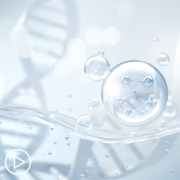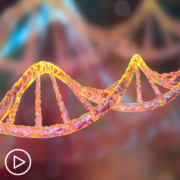How Can CLL HCPs Gain More Understanding of Mutation Profiles?
How Can CLL HCPs Gain More Understanding of Mutation Profiles? from Patient Empowerment Network on Vimeo.
How might chronic lymphocytic leukemia (CLL) HCPs gain more understanding of mutation profiles? Experts Dr. Jennifer Brown from Dana-Farber Cancer Institute and Dr. Callie Coombs from the University of California, Irvine discuss several mutations, how they commonly impact treatment, and acquired resistance to inhibitors.
Download Resource Guide | Descargar guía de recursos
Related Resources:

CLL Expert Updates on Diagnostic Tool and Technology Advances |

CLL Clinical Trials for Molecularly Defined Patient Subgroups |

Managing CLL Side Effects | Innovative Strategies and Approaches |
Transcript:
Dr. Nicole Rochester:
Dr. Brown, how do CLL healthcare providers better understand mutation profiles including the emergence of novel CLL mutations over time?
Dr. Jennifer Brown:
Well, the first thing that’s important to recognize is that CLL is not defined by any particular mutation. The landscape is quite varied and we see a large number of different mutations at low percentages. Well, the second key point to remember is that there are different mutations at baseline and then there can be acquired mutations that include some of what we see at baseline, but also novel resistance mutations that we don’t ever see at base.
So at baseline, the most common mutations, which are somewhere in the 10 to 20 percent range of patients, although less than that if you have very early stage patients, affect the p53 gene, NOTCH1, SF3B1, and ATM. P53 is the most important because that one does influence our thinking about the patients and our choice of therapy in some cases. P53 can be altered in CLL in two different ways. Actually, the most common way is as a deletion, deletion of the short arm of chromosome 17 or 17P deletion. About 75 to 80 percent of patients that have that deletion will have a point mutation usually in the other p53 allele. So they have double knockout of p53.
A small percentage of people with the deletion will not have the mutation. And then a certain number of patients will have just the mutation without the deletion. And one of the things that I’ve been very interested in for a while that we’re still trying to understand better is the implications of these different combinations of the way p53 can be affected in people with CLL, and that it may, in fact, be more adverse to have both alleles knocked out than single, although we don’t have great data for that as yet because most of the data that we have has combined all of it together.
But it’s very important to test for the p53 mutation alone because even if patients have only that one, at present, we consider the treatment implications of it all similarly regardless of how the p53 gene is affected. And then NOTCH1 is a fairly common mutation that always worries us a lot, because it’s associated with Richter’s transformation, which is a very high-risk event, but we don’t know anything to do about that to try and prevent it or to alter our therapy based on it.
So at the moment it’s mostly something that we are aware of that we keep an eye on but not that changes therapy. And SF3B1, ATM, and this long list of other genes that can be mutated in just a few percent of CLL, and mostly what we know about them is some biology that’s been studied, and then the fact that the more of these mutations are mutated in a patient that is associated with a worse prognosis, just a total number.
But that’s not something also that really alters our therapy. And then when patients go through lines of therapy, they can sometimes acquire mutations in these genes. So a patient can acquire a mutation in p53 or in NOTCH after their second or third line of therapy. But the mutations that are hottest right now, or that people are most interested in are some of the mutations that occur as resistance to therapy.
So in particular, that means BTK mutations. Covalent BTK inhibitors have transformed the therapy of CLL, and they bind to the cysteine 481 residue of BTK. So that means, as you might imagine, that if you mutate that cysteine so that the inhibitor can’t bind, that will be associated with resistance. And that, in fact, is what has been found that the cysteine to serine mutation at 481 is the most common resistance mutation in patients on covalent BTK inhibitors.
And in the case of ibrutinib (Imbruvica), it makes the inhibitor into a much weaker and non-covalent inhibitor. In the case of acalabrutinib (Calquence) and zanubrutinib (Brukinsa), it probably abrogates all activity. And so that’s a mutation that we will sometimes look for in patients with clinical progression on those drugs. There’s also a mutation in BCL2 that can occur in patients in venetoclax (Venclexta).
So another example of an on target resistance mutation. The role of that one is a little bit less clear, and testing for it is not as widely available, but we’re still working on that. Resistance to venetoclax is probably more complicated than resistance to BTK inhibitors, although there’s also a subset of patients who will get BTK inhibitors who have novel mechanisms of resistance not related to BTK that we don’t really know anything about as yet.
And then finally, the non-covalent BTK inhibitors are becoming available, pirtobrutinib (Jaypirca) was approved for CLL in the United States in December for patients who’ve had covalent BTK inhibitors and venetoclax. And we’re starting to see different mutations in BTK at different sites, even though pirtobrutinib has activity against the 481 mutation. So there’s going to be a lot of activity in this area in the next few years probably.
Dr. Nicole Rochester:
Thank you so much Dr. Brown, that was a very comprehensive overview of the mutations. Dr. Coombs, do you have anything that you want to add to what Dr. Brown said perhaps specifically around mutations associated with the progression of CLL?
Dr. Callie Coombs:
Sure. So, that’s a hard act to follow. She really took us through a whirlwind of everything mutation-related. I think what I would like to focus on in my answer is, well, what should we be testing for on a day-to-day basis in our CLL practices and what are some common misconceptions? So specific to TP53, I would say this is the most important test as far as all of the genetic tests that influences what we do day to day in the care of patients with CLL.
I test for this for my newly diagnosed patients who I think may be interested in enrolling in a clinical trial, first of all, so the standard of care in CLL is watch and wait, however, patients with higher risk disease may be eligible for trials looking at early intervention specifically the SWOG EVOLVE trial looking at early treatment. And so that’s one of the risk markers that can get a patient into the higher risk category of CLL where they could be eligible for a trial.
A common misconception I see is that 17p is the same thing as a TP53 mutation, it’s definitely not. So these are two different tests that have to be sent. 17p can be picked up on karyotype testing and on FISH testing where it looks for 17p deletion. However, mutations are a different test. And so I usually send a next gen sequencing assay that includes other genes.
However, you can test purely just for mutations in the TP53 gene, but again, that’s a sequencing test, so I’d like to convey that, somewhat a misunderstanding, but it’s such an important gene in CLL because when patients have TP53 aberrations, whether that’s 17P or a TP53 mutation or both, given that they can occur in isolation or together, these patients should never get chemotherapy, because they have extremely terrible responses to chemo, and that should not be part of the therapies offered to these patients.
The other interesting, I’d say controversial at least in 2024, is what is the role for mutation testing in the clinic in the setting of acquired resistance to inhibitors? So I think it’s very clearly important in the research setting where I think learning about the C481 mutation among others in the setting of covalent BTK inhibitors has shown us a lot about mechanism of resistance. But in the clinic, I don’t necessarily think that’s something that needs to be universally applied, given that it most of the time doesn’t affect what we would do clinically. And so one example is a patient comes in progressing on ibrutinib, maybe about two-thirds of them may have a mutation in the C481S. However, if they’re clinically progressing, they need to switch therapy.










